Introduction
Ontario conducts its borrowing program responsibly and prudently to minimize interest on debt (IOD) costs.
Ontario’s long-term borrowing requirement for 2024–25 is now forecast to be $37.5 billion, unchanged from the 2024–25 First Quarter Finances. The improved deficit position and corresponding decrease in funding requirements allow Ontario to increase cash reserves, enhancing liquidity and flexibility for future years. The short-term borrowing program forecasts remain unchanged from the 2024 Budget. About 84 per cent, or $31.4 billion, of this year’s long‑term borrowing requirement has been completed to date.
Ontario’s net debt-to-GDP ratio is now forecast to be 37.8 per cent in 2024–25, compared with the forecast of 39.2 per cent in the 2024 Budget. Ontario’s net debt-to-GDP ratio fell to a 12-year low last year, and Ontario’s plan keeps this ratio below levels seen since 2011–12.
Ontario’s net debt-to-revenue is now forecast to be 202 per cent in 2024–25, compared with the forecast of 214 per cent in the 2024 Budget and would be the lowest since 2010–11 with the exception of last fiscal year.
Ontario is forecast to pay $12.7 billion in interest costs in 2024–25, about $1.2 billion lower than the 2024 Budget forecast, primarily due to lower borrowing costs in 2023–24 that have carried forward. Ontario’s 2024–25 interest on debt-to-revenue is forecast to be 6 per cent, a decrease of 0.8 percentage points from the 2024 Budget forecast of 6.8 per cent. The 6 per cent ratio projected for this fiscal year would be the second lowest since the 1980s, trailing only last year’s 5.5 per cent.
Borrowing Program
Ontario’s borrowing program is primarily used to refinance maturing debt, make investments in capital assets and fund deficits. Ontario will continue to finance most of its borrowing program in the long-term public markets in Canada and internationally.
Ontario’s long-term borrowing requirement for 2024–25 is now forecast to be $37.5 billion. The improved deficit position and corresponding decrease in funding requirements allow Ontario to increase cash reserves, enhancing liquidity and flexibility for future years.
| 2024 Budget | In-Year Change | Current Outlook 2024–25 |
Medium-Term Outlook 2025–26 |
Medium-Term Outlook 2026–27 |
|
|---|---|---|---|---|---|
| Deficit/(Surplus) | 9.8 | (3.2) | 6.6 | 1.5 | (0.9) |
| Investment in Capital Assets | 17.7 | – | 17.7 | 20.9 | 20.6 |
| Non-Cash and Cash Timing Adjustments | (11.0) | – | (11.0) | (12.0) | (13.9) |
| Net Loans and Investments | (0.3) | 1.1 | 0.8 | (0.2) | – |
| Debt Maturities and Redemptions | 28.0 | – | 28.0 | 33.1 | 26.9 |
| Total Funding Requirement | 44.2 | (2.1) | 42.2 | 43.3 | 32.6 |
| Decrease/(Increase) in Short-Term Borrowing | (5.0) | – | (5.0) | – | – |
| Increase/(Decrease) in Cash and Cash Equivalents1 | (1.0) | 1.3 | 0.3 | (8.3) | – |
| Total Long-Term Borrowing | 38.2 | (0.7) | 37.5 | 35.0 | 32.6 |
Table 4.1 footnotes:
[1] Starting in 2024–25, pre-borrowing will be reflected as part of the increase in year-end cash and cash equivalents.
Note: Numbers may not add due to rounding.
Source: Ontario Financing Authority.
As of October 15, 2024, $31.4 billion, or 84 per cent, of this year’s long-term public borrowing has been completed. Investments in capital assets are important in supporting Ontario’s economy and are a large component of the total funding requirements. These critical infrastructure investments ensure Ontario is well-positioned to continue supporting communities, people and businesses while creating a strong foundation for Ontario’s long-term economic growth.
Over the three-year outlook period, total long-term borrowing is now forecast to be $3.6 billion lower than forecast in the 2024 Budget. In the event that alternative economic scenarios materialize, Ontario’s borrowing requirements in the next three years would also change (see Chapter 3: Ontario’s Fiscal Plan and Outlook for further details, and a description of the resulting alternative medium-term outlook scenarios). Under the Faster Growth scenario, long-term borrowing would decrease by $20.7 billion over the three-year outlook period, while under the Slower Growth scenario, long‑term borrowing would increase by $18.3 billion over the same period.
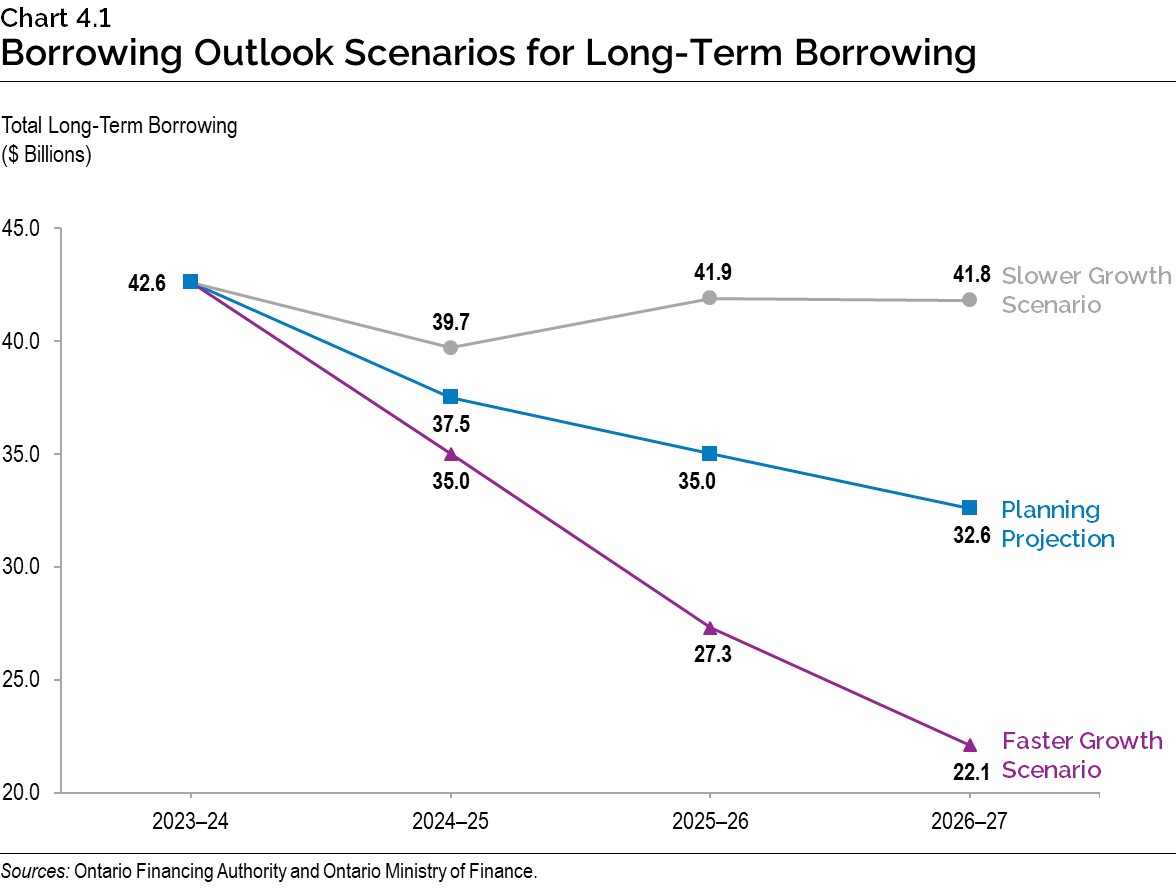
To date, approximately 80 per cent of 2024–25 long-term borrowing was completed in Canadian dollars, through 24 syndicated issues, and two Green Bonds. The remaining 20 per cent was completed in foreign currencies in U.S. dollars and Australian dollars. Ontario’s target range for domestic borrowing remains unchanged at 75 to 90 per cent of borrowing completed for the 2024–25 fiscal year. This range could be adjusted, if necessary, in response to evolving investor demand in the Canadian dollar and foreign currency debt markets.
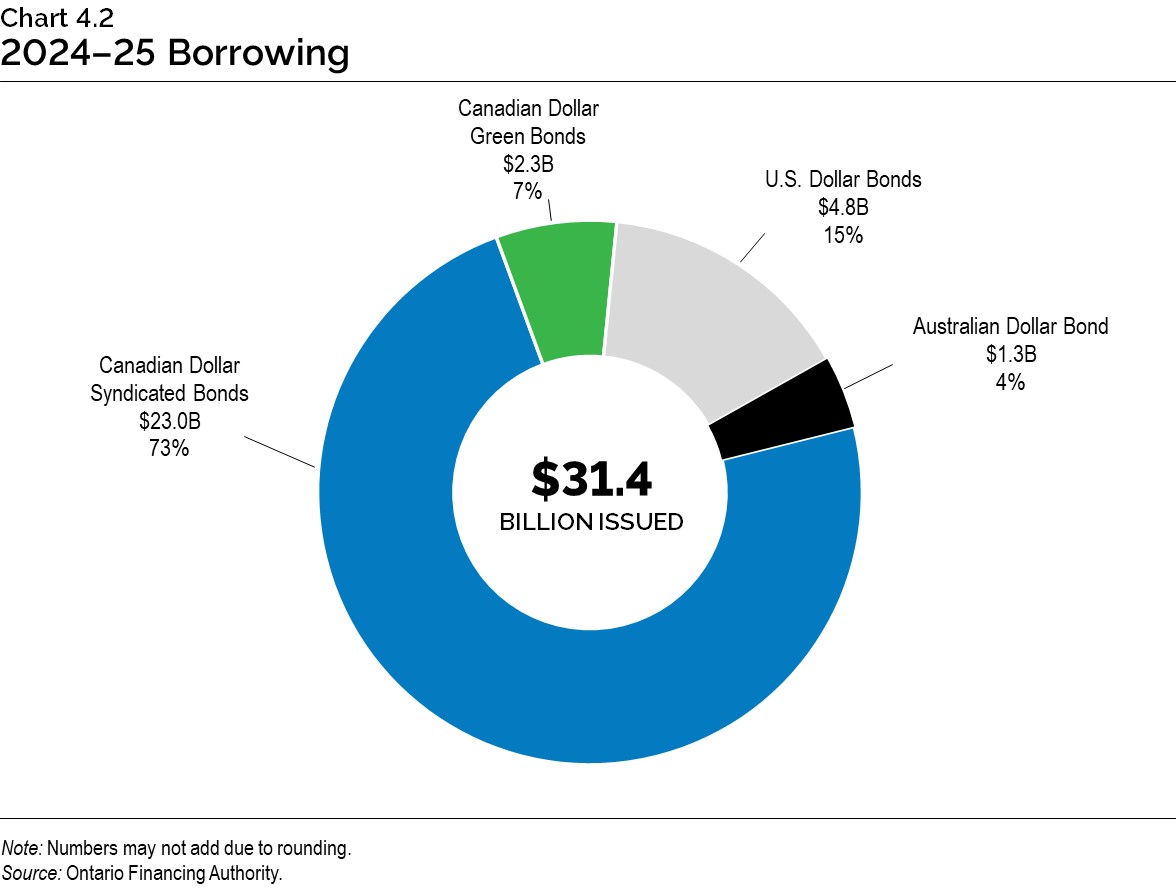
Foreign currency borrowing helps reduce Ontario’s overall borrowing costs by continuing to diversify Ontario’s investor base. This diversification ensures the government will continue to have access to capital, even if domestic market conditions become challenging.
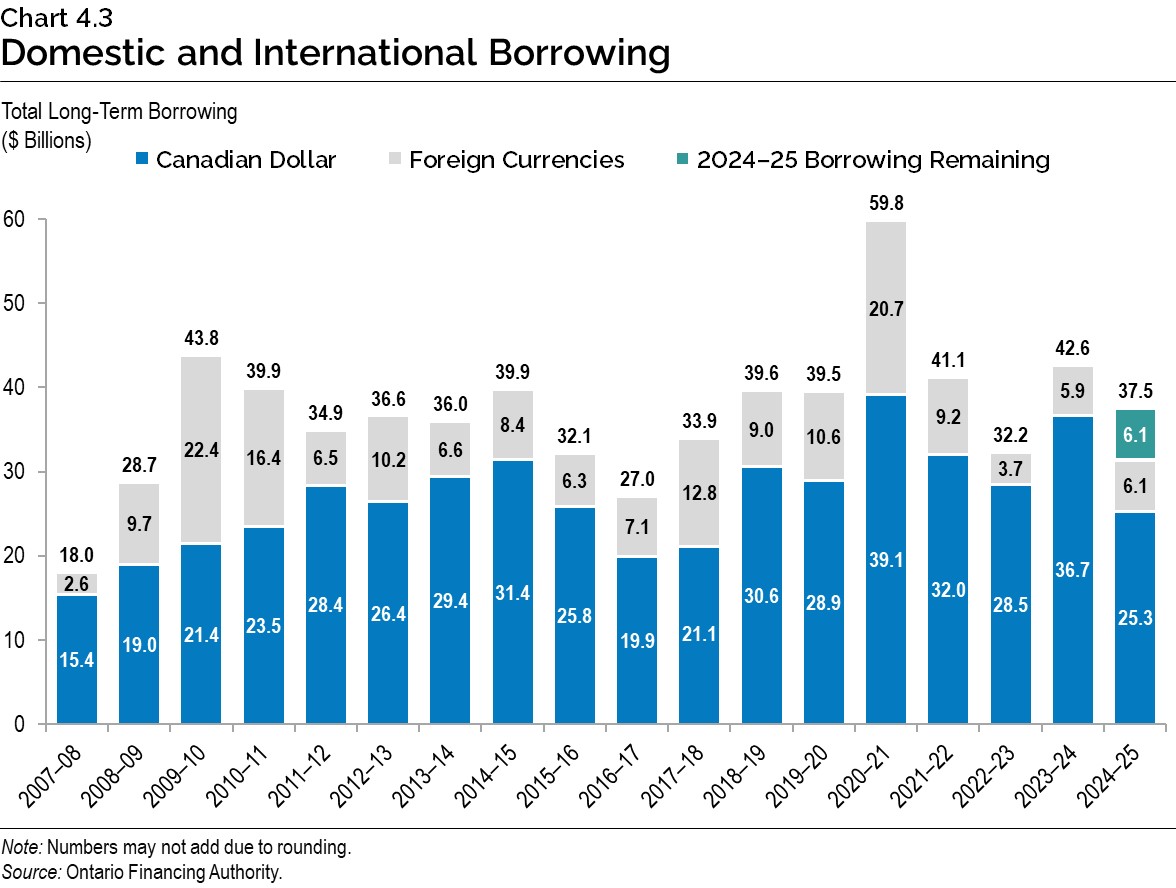
Sustainable Bond Program
Green Bonds remain a core component of Ontario’s borrowing program and are an important tool to help finance public transit initiatives, extreme weather-resistant infrastructure, as well as energy efficiency and conservation projects. Ontario remains the largest and most frequent issuer of Canadian dollar Green Bonds, with 17 issues totalling $20.25 billion issued since 2014–15, with $18.2 billion outstanding.
In January 2024, the government released the new Ontario Sustainable Bond Framework, replacing its Green Bond Framework from 2014. The new framework will allow for a broader range of potential bond offerings in the future, including emissions-free nuclear power.
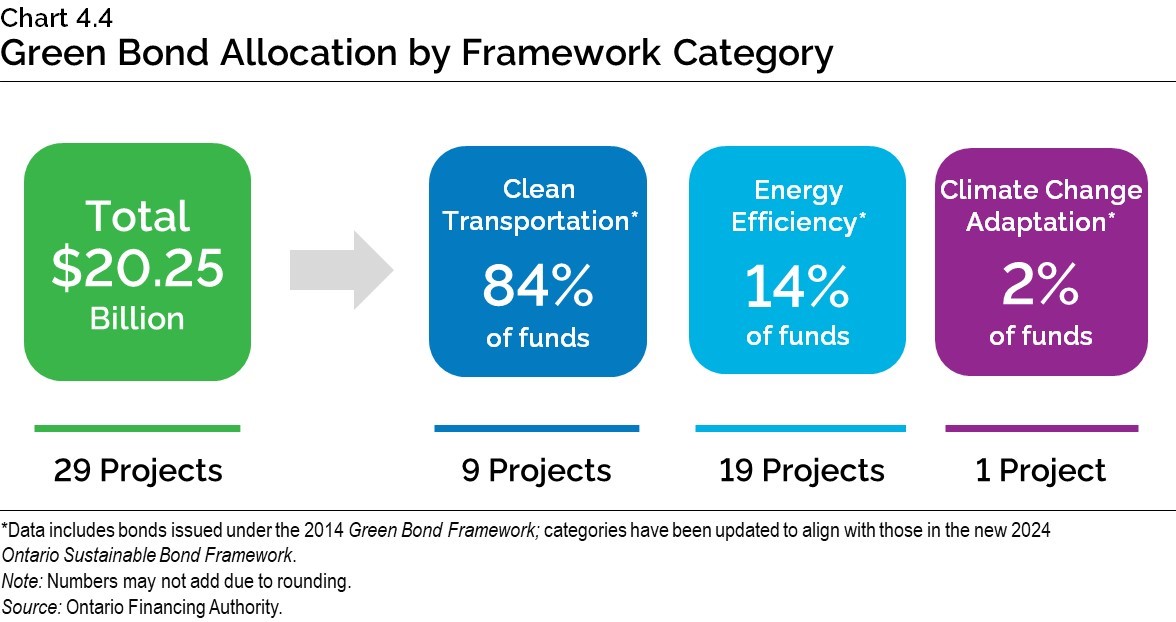
On October 2, 2024, Ontario issued a $1 billion Green Bond. This was the second Green Bond issued in 2024–25, the seventeenth Green Bond overall, and Ontario’s third Green Bond issued under the new Ontario Sustainable Bond Framework. This bond was also the largest 30-year Canadian dollar Green Bond and the first ever 30-year Green Bond by a Canadian province. Four projects were selected to receive funding from the most recent Green Bond:
- Go Transit Expansion;
- Hazel McCallion Light Rail Transit;
- Ontario Line Subway; and
- Scarborough Subway Extension.
Ontario plans to continue its leadership in the Canadian dollar Green Bond market and, subject to market conditions, will issue multiple Green Bonds each fiscal year.

Cost of Debt
Central banks globally, including the Bank of Canada and the U.S. Federal Reserve, have begun lowering overnight interest rates. Ontario actively manages financial market risks and adapts interest rate risk management strategies to minimize the impact of changing market conditions on Ontario’s IOD costs. Chart 4.6 shows Ontario’s decision to lock in long-term rates and extend the term of its debt, since the Global Financial Crisis in 2007–08 has left the interest rate on the total debt portfolio low in historical terms, in spite of broader market interest rates rising coming out of the pandemic.
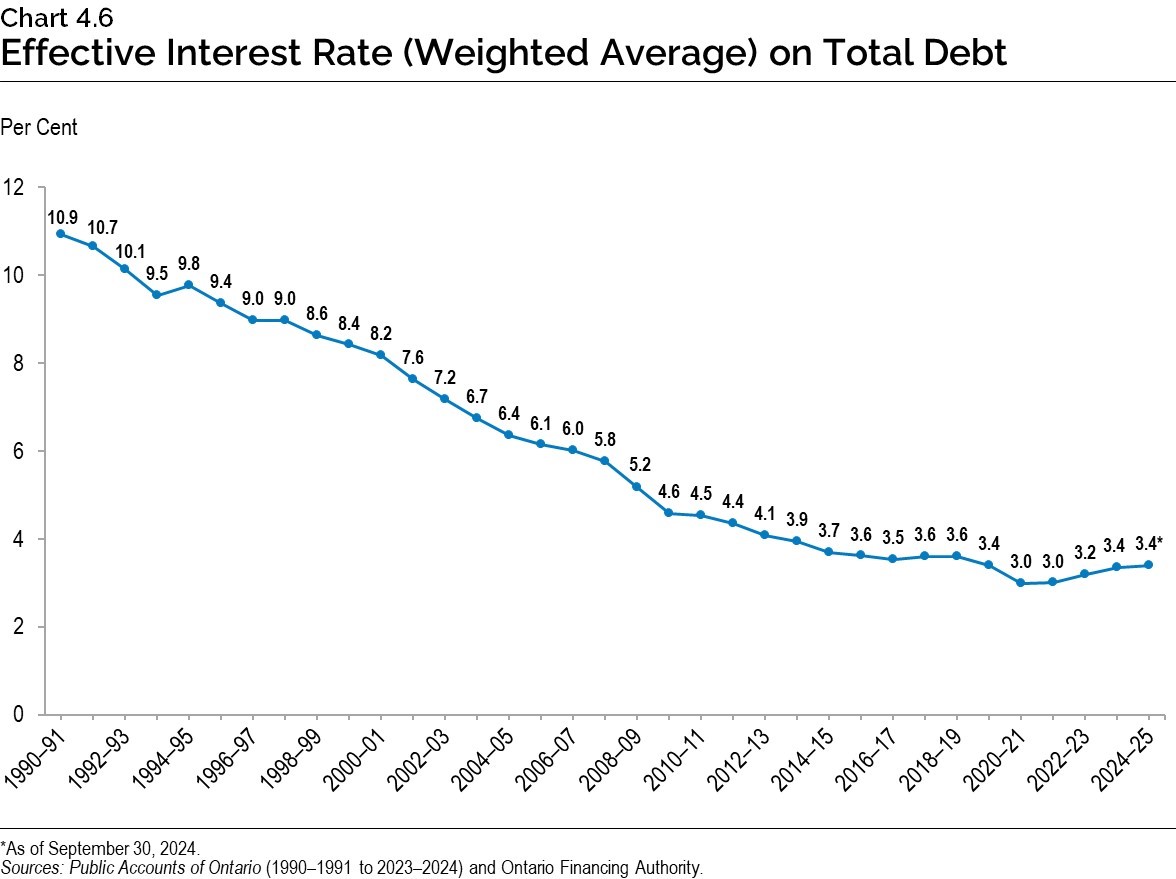
Ontario’s estimated cost of borrowing for 2024–25 remains at 4 per cent, as long-term rates have remained within the range forecasted in the 2024 Budget. A one percentage point change in interest rates either up or down from the current interest rate forecast is estimated to have a corresponding change in Ontario’s borrowing costs of approximately $700 million in the first full year.
Chart 4.7 shows the average borrowing rates on debt issued in 2023–24 and the forecasts used to estimate the cost of borrowing for 2024–25 and the medium-term outlook. The forecast rates remain unchanged from the 2024 Budget.
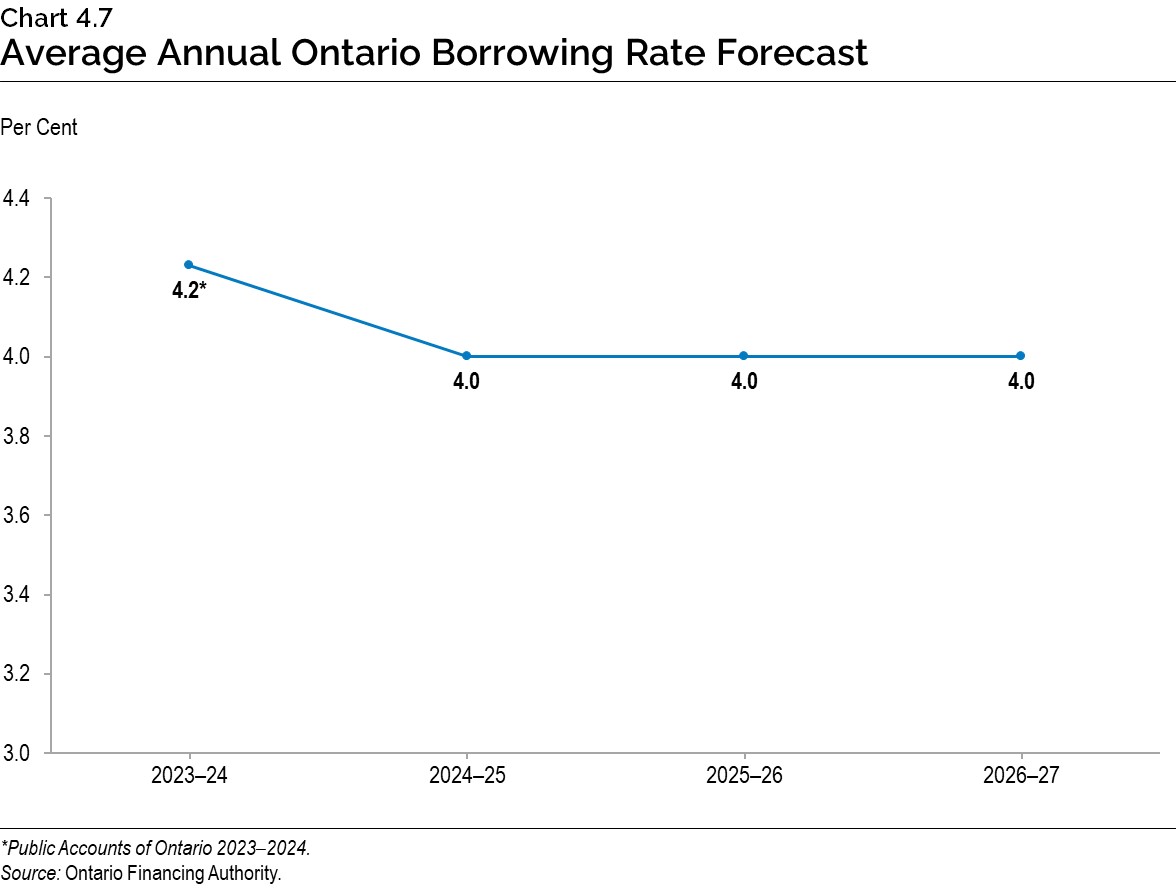
Chart 4.8 shows that over the four-year period from 2023–24 through 2026–27, the cumulative IOD expense is estimated to be $4.1 billion below the 2024 Budget forecast. This is primarily due to lower borrowing costs in 2023–24 as reported in the Public Accounts of Ontario 2023–2024 carrying forward. IOD remains Ontario’s fourth largest expense after health care, education and social services.
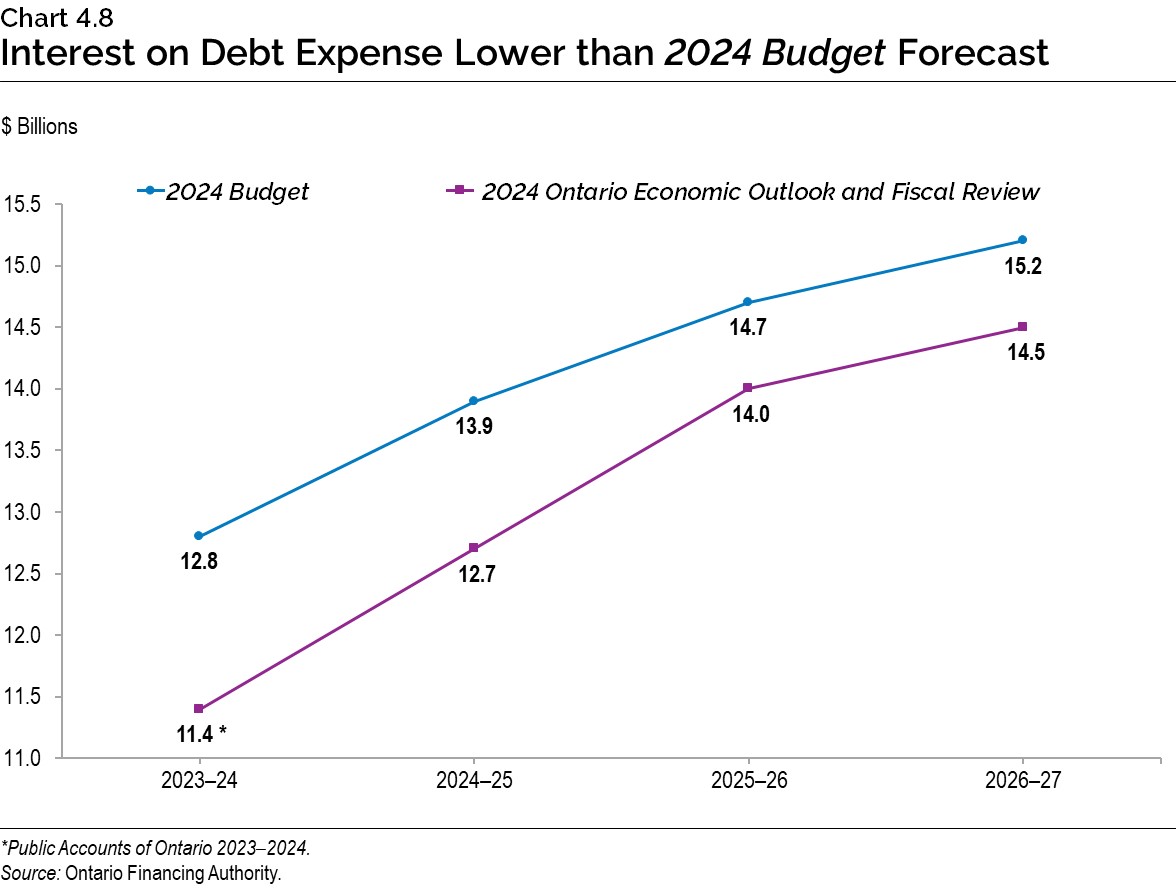
Term of Debt
Ontario has continued to extend the term of its debt, when investor demand allowed, to reduce refinancing risk on maturing debt. This also protects the IOD forecast in the long term against future interest rate increases. Ontario has issued $147 billion of bonds, or almost a third of total debt, with maturities of 30 years or longer since 2010–11. This includes $9.8 billion so far in 2024–25.
The success Ontario has had in extending the term of its debt from the time of the Global Financial Crisis has created flexibility for managing its large borrowing program and debt portfolio. Due to the extension of the term of debt, the impact on IOD in the short term and medium term has been lessened. Ontario will continue to monitor the market and adjust the debt term strategy in response to further changes to interest rates and the yield curve.
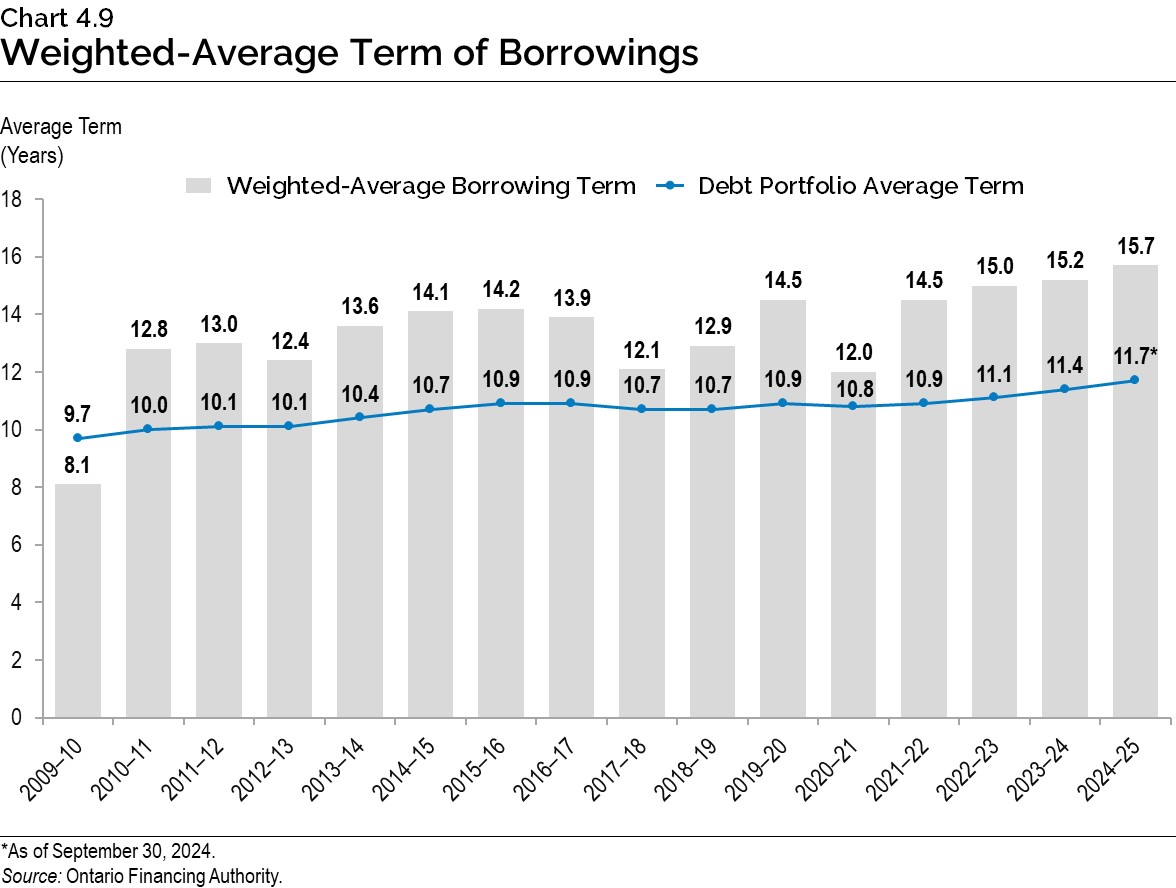
Ensuring Adequate Liquidity Levels
Ontario aims to maintain a level of cash reserves that balances potential holding costs with the need to have adequate funds to meet its financial obligations in a timely manner, as well as to be able to respond promptly to unforeseen market events or economic shocks. With short-term interest rates higher than long-term rates through 2023–24, holding liquid reserves reduced IOD as short-term investments earned more income than Ontario’s cost of borrowing long-term debt.
As shown in Chart 4.10, Ontario’s cash reserves for 2024–25 are projected to be $43.4 billion.
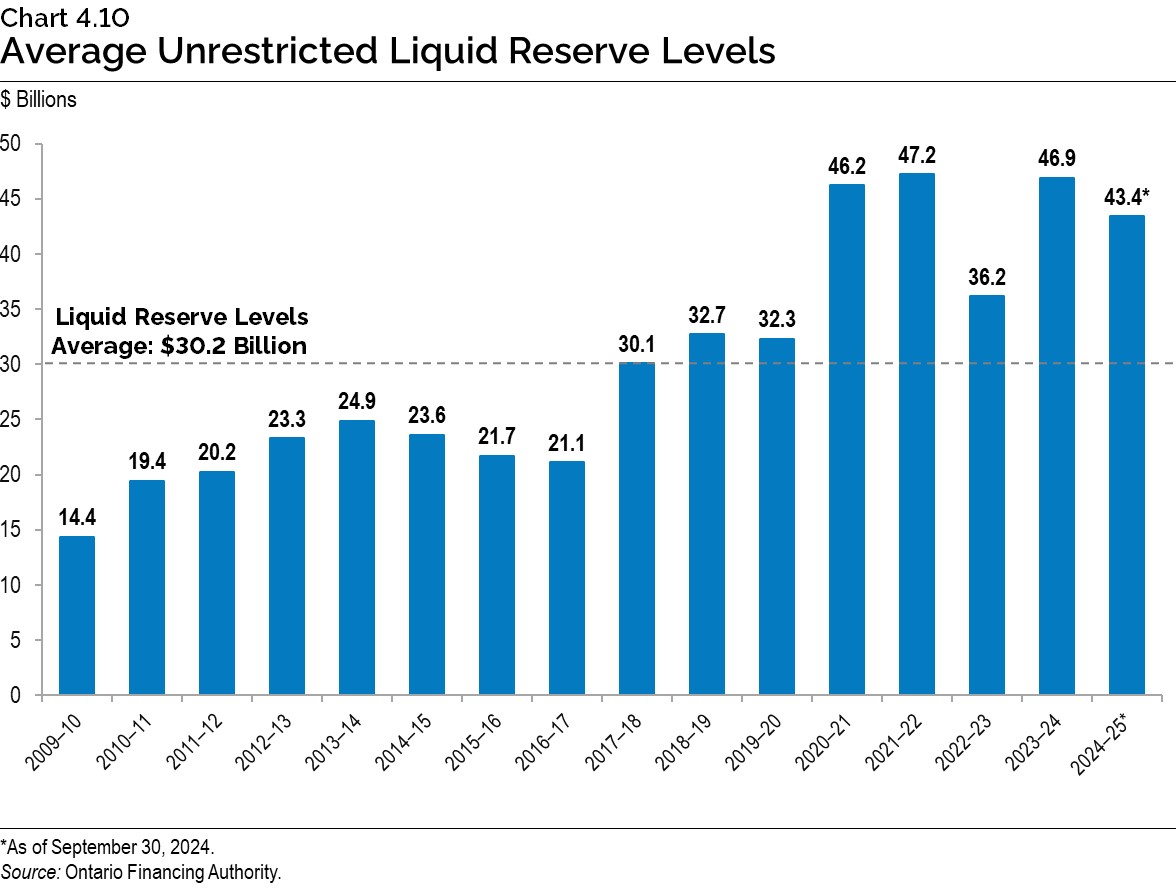
Progress on the Debt Burden Reduction Strategy
The government remains committed to reducing the debt burden and putting Ontario’s finances back on a more sustainable path. As part of this effort, Ontario has maintained its targets set in the 2023 Budget. Ontario remains committed to achieving these targets over the medium-term outlook. In addition, to increase and improve Ontario’s transparency and accountability, the 2025 Budget will report interest and investment revenue earned separately from interest expense. This change will have no fiscal or economic impact, but is intended to increase transparency by fully complying with Public Sector Accounting Standards.
| 2024 Budget Target |
2024 Budget 2024–25 |
2024 FES 2024–25 |
|
|---|---|---|---|
| Net Debt-to-GDP | <40.0 | 39.2 | 37.8 |
| Net Debt-to-Revenue | <200 | 214 | 202 |
| Interest on Debt-to-Revenue | <7.5 | 6.8 | 6.0 |
Table 4.2 footnotes:
Note: 2024 FES in the table is defined as the 2024 Ontario Economic Outlook and Fiscal Review.
Source: Ontario Financing Authority.
Ontario’s 2024–25 net debt-to-GDP ratio is now forecast to be 37.8 per cent, a decrease of 1.4 percentage points from the forecasted 39.2 per cent in the 2024 Budget, which is mainly due to lower than previously projected deficits. This ratio measures the relationship between a government’s obligations and its ability to meet them, indicating the burden of government debt as a share of the economy. Ontario’s net debt-to-GDP is now forecast to be 37.9 per cent in 2025–26 and 37.5 per cent in 2026–27, compared to the 2024 Budget forecasts of 39.5 per cent and 39.1 per cent, respectively.
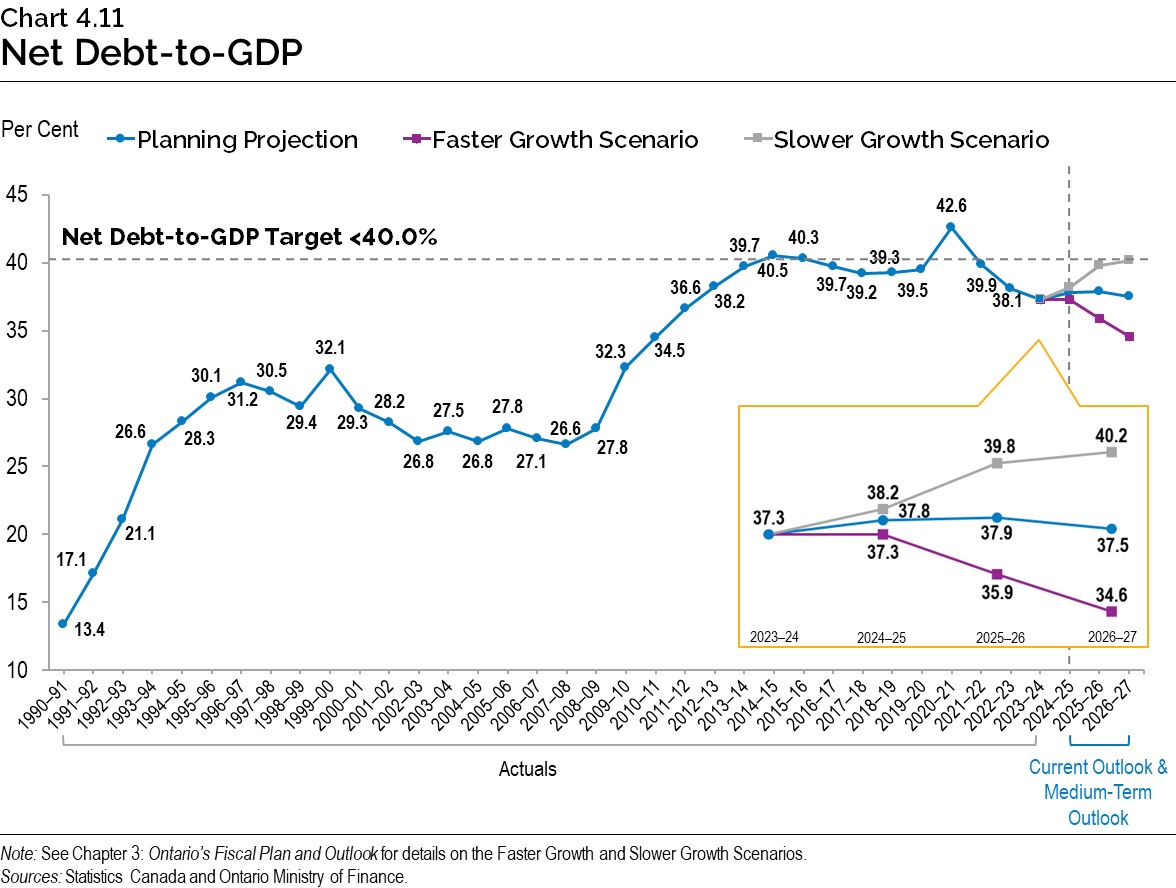
The net debt‑to-revenue ratio is projected to be 202 per cent in 2024–25, 12 percentage points below the 214 per cent forecast in the 2024 Budget. This ratio is an indicator of how many years it would take to eliminate the debt if the Ontario government were to spend all its annual revenue on debt repayment. Over the medium-term outlook, this ratio is forecast to be 203 per cent in 2025–26 and 200 per cent in 2026–27, lower by 8 percentage points and 9 percentage points, respectively, compared to the forecasts in the 2024 Budget.
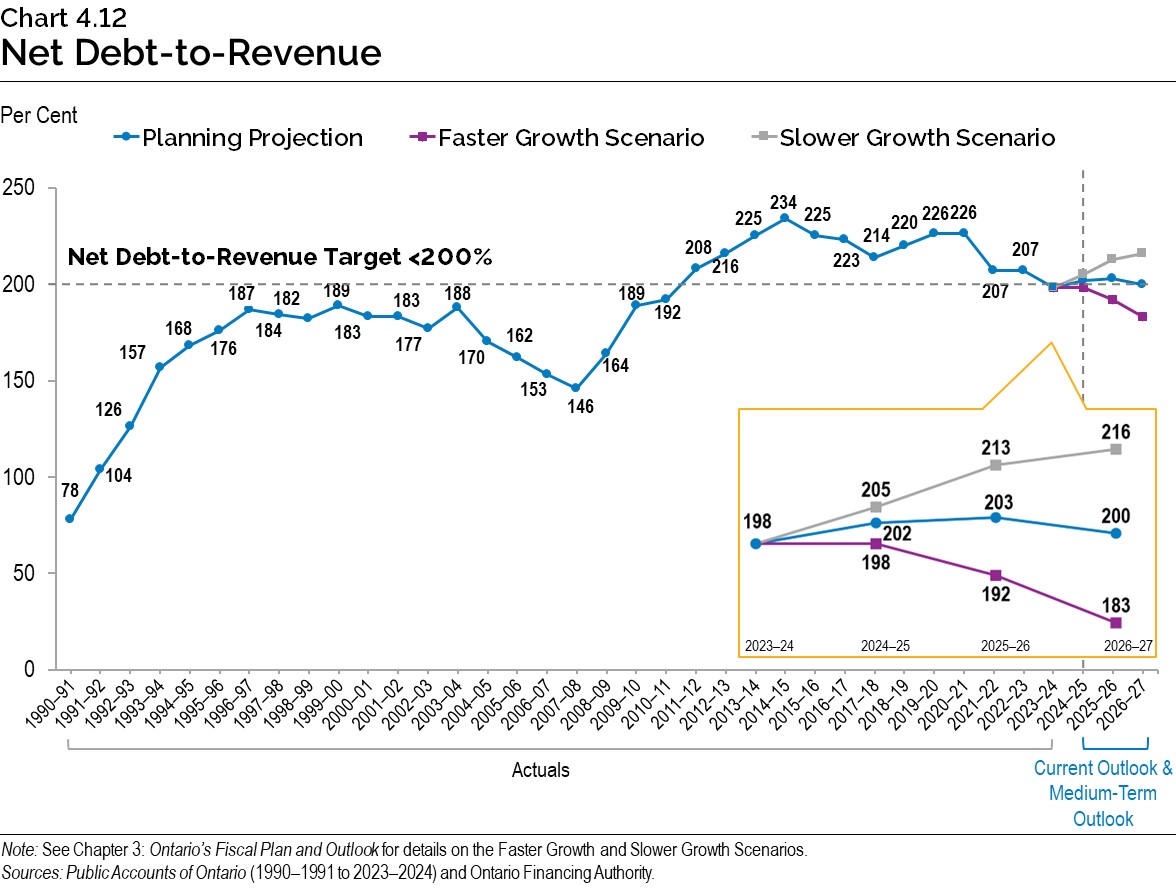
The IOD-to-revenue ratio is forecast to be 6 per cent in 2024–25, 0.8 percentage points lower than the 6.8 per cent forecast in the 2024 Budget. This ratio represents how much Ontario needs to spend on interest for every revenue dollar received. A lower IOD-to-revenue ratio frees up more resources for other priorities.
Ontario continues to show positive progress on the IOD-to-revenue ratio and is forecasting to meet the target and stay below 7.5 per cent over the medium-term outlook. This ratio remains close to the lowest levels it has been at since the 1980s.
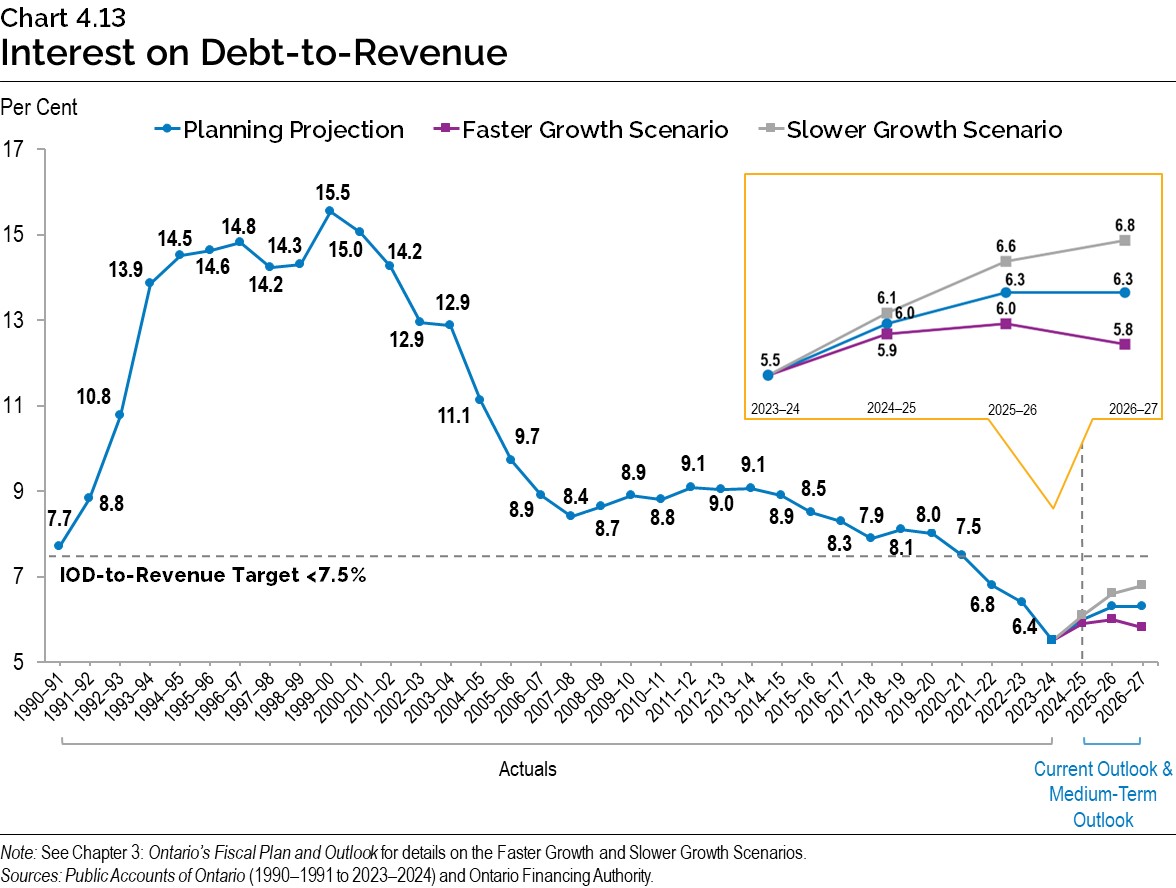
To fully comply with the Public Sector Accounting Standards, interest and investment income will no longer be subtracted from IOD and will be reported separately as revenue going forward. The impact of this change is fiscally and economically neutral, and represents an accounting reporting and presentation change. The IOD-to-revenue ratio will continue to be calculated on a net basis after the accounting change is implemented, to remain comparable with the historical data and to continue to provide an appropriate measure of Ontario’s net interest costs from a financial markets perspective.
Chart Descriptions
Chart 4.1: Borrowing Outlook Scenarios for Long-Term Borrowing
($ Billions)
| Year | 2023–24 | 2024–25 | 2025–26 | 2026–27 |
|---|---|---|---|---|
| Planning Projection | 42.6 | 37.5 | 35.0 | 32.6 |
| Slower Growth Scenario | 42.6 | 39.7 | 41.9 | 41.8 |
| Faster Growth Scenario | 42.6 | 35.0 | 27.3 | 22.1 |
Sources: Ontario Financing Authority and Ontario Ministry of Finance.
Chart 4.2: 2024–25 Borrowing
Long-term public borrowing of $31.4 billion has been completed for fiscal year 2024–25. This consisted of $23.0 billion (73 per cent) of Canadian dollar syndicated bonds, $2.3 billion (7 per cent) Canadian dollar Green Bonds, $1.3 billion (4 per cent) of Australian dollar bond, and $4.8 billion (15 per cent) of U.S. dollar bonds.
Note: Numbers may not add due to rounding.
Source: Ontario Financing Authority.
Chart 4.3: Domestic and International Borrowing
Ontario’s total long-term borrowing completed in 2024–25 is forecast to be $37.5 billion — $25.3 billion was borrowed in the Canadian dollar market and $6.1 billion was borrowed in foreign currencies, with $6.1 billion of borrowing remaining for 2024–25.
| Year | Canadian Dollar ($ Billions) | Foreign Currencies ($ Billions) | Total ($ Billions) |
|---|---|---|---|
| 2007–08 | 15.4 | 2.6 | 18.0 |
| 2008–09 | 19.0 | 9.7 | 28.7 |
| 2009–10 | 21.4 | 22.4 | 43.8 |
| 2010–11 | 23.5 | 16.4 | 39.9 |
| 2011–12 | 28.4 | 6.5 | 34.9 |
| 2012–13 | 26.4 | 10.2 | 36.6 |
| 2013–14 | 29.4 | 6.6 | 36.0 |
| 2014–15 | 31.4 | 8.4 | 39.9 |
| 2015–16 | 25.8 | 6.3 | 32.1 |
| 2016–17 | 19.9 | 7.1 | 27.0 |
| 2017–18 | 21.1 | 12.8 | 33.9 |
| 2018–19 | 30.6 | 9.0 | 39.6 |
| 2019–20 | 28.9 | 10.6 | 39.5 |
| 2020–21 | 39.1 | 20.7 | 59.8 |
| 2021–22 | 32.0 | 9.2 | 41.1 |
| 2022–23 | 28.5 | 3.7 | 32.2 |
| 2023–24 | 36.7 | 5.9 | 42.6 |
| 2024–25 | 25.3 | 6.1 | 37.5 |
Note: Numbers may not add due to rounding.
Source: Ontario Financing Authority.
Chart 4.4: Green Bond Allocation by Framework Category
A total of $20.25 billion in Green Bond funding has provided funding for 29 projects. Nine of those projects are under the Clean Transportation framework category and have received 84 per cent of the funding. Nineteen projects are under the Energy Efficiency category and have received 14 per cent of the funding. One project is under the Climate Change Adaptation category and has received 2 per cent of the funding.
Note: Numbers may not add due to rounding.
Source: Ontario Financing Authority.
Chart 4.5: Ontario’s Green Bond Issues
Since 2014, Ontario has issued Green Bonds totalling $20.25 billion.
| Year | 2014–15 | 2015–16 | 2016–17 | 2017–18 | 2018–19 | 2019–20 | 2020–21 | 2021–22 | 2022–23 | 2023–24 | 2024–25 |
|---|---|---|---|---|---|---|---|---|---|---|---|
| Green Bond Issues ($) | $0.5 billion | $0.75 billion | $0.8 billion | $1.0 billion | $0.95 billion | $1.25 billion |
$2.75 billion | $4.5 billion | $2.5 billion | $3.0 billion | $2.25 billion |
Source: Ontario Financing Authority.
Chart 4.6: Effective Interest Rate (Weighted Average) on Total Debt
As of September 30, 2024, the effective interest rate (calculated as a weighted average) for
fiscal year-end is forecast to be 3.4 per cent on Ontario’s total debt.
| Year | Effective Interest Rate (%) |
|---|---|
| 1990–91 | 10.9 |
| 1991–92 | 10.7 |
| 1992–93 | 10.1 |
| 1993–94 | 9.5 |
| 1994–95 | 9.8 |
| 1995–96 | 9.4 |
| 1996–97 | 9.0 |
| 1997–98 | 9.0 |
| 1998–99 | 8.6 |
| 1999–00 | 8.4 |
| 2000–01 | 8.2 |
| 2001–02 | 7.6 |
| 2002–03 | 7.2 |
| 2003–04 | 6.7 |
| 2004–05 | 6.4 |
| 2005–06 | 6.1 |
| 2006–07 | 6.0 |
| 2007–08 | 5.8 |
| 2008–09 | 5.2 |
| 2009–10 | 4.6 |
| 2010–11 | 4.5 |
| 2011–12 | 4.4 |
| 2012–13 | 4.1 |
| 2013–14 | 3.9 |
| 2014–15 | 3.7 |
| 2015–16 | 3.6 |
| 2016–17 | 3.5 |
| 2017–18 | 3.6 |
| 2018–19 | 3.6 |
| 2019–20 | 3.4 |
| 2020–21 | 3.0 |
| 2021–22 | 3.0 |
| 2022–23 | 3.2 |
| 2023–24 | 3.4 |
| 2024–25 | 3.4* |
*As of September 30, 2024.
Sources: Public Accounts of Ontario (1990–1991 to 2023–2024) and Ontario Financing Authority.
Chart 4.7: Average Annual Ontario Borrowing Rate Forecast
| Year | 2024 Ontario Economic Outlook and Fiscal Review (%) |
|---|---|
| 2023–24 | 4.2* |
| 2024–25 | 4.0 |
| 2025–26 | 4.0 |
| 2026–27 | 4.0 |
*Public Accounts of Ontario 2023–2024.
Source: Ontario Financing Authority.
Chart 4.8: Interest on Debt Expense Lower than 2024 Budget Forecast
| Year | 2024 Ontario Economic Outlook and Fiscal Review ($ Billions) | 2024 Budget ($ Billions) |
|---|---|---|
| 2023–24 | 11.4* | 12.8 |
| 2024–25 | 12.7 | 13.9 |
| 2025–26 | 14.0 | 14.7 |
| 2026–27 | 14.5 | 15.2 |
*Public Accounts of Ontario 2023–2024.
Source: Ontario Financing Authority.
Chart 4.9: Weighted-Average Term of Borrowings
The average term of Ontario’s debt portfolio has been extended from 9.7 years in 2009–10 to 11.7 years in 2024–25. The weighted-average borrowing term for 2024–25 was 15.7 years as of October 7, 2024.
| Year | 2009–10 | 2010–11 | 2011–12 | 2012–13 | 2013–14 | 2014–15 | 2015–16 | 2016–17 | 2017–18 | 2018–19 | 2019–20 | 2020–21 | 2021–22 | 2022–23 | 2023–24 | 2024–25 |
|---|---|---|---|---|---|---|---|---|---|---|---|---|---|---|---|---|
| Weighted-Average Borrowing Term (Years) | 8.1 | 12.8 | 13.0 | 12.4 | 13.6 | 14.1 | 14.2 | 13.9 | 12.1 | 12.9 | 14.5 | 12.0 | 14.5 | 15.0 | 15.2 | 15.7 |
| Debt Portfolio Average Term (Years) | 9.7 | 10.0 | 10.1 | 10.1 | 10.4 | 10.7 | 10.9 | 10.9 | 10.7 | 10.7 | 10.9 | 10.8 | 10.9 | 11.1 | 11.4 | 11.7* |
*As of September 30, 2024.
Source: Ontario Financing Authority.
Chart 4.10: Average Unrestricted Liquid Reserve Levels
Average unrestricted liquid reserve levels are forecast to be $43.4 billion as of September 30, 2024.
| Year | Average Unrestricted Liquid Reserve Levels ($ billions) |
|---|---|
| 2009–10 | 14.4 |
| 2010–11 | 19.4 |
| 2011–12 | 20.2 |
| 2012–13 | 23.3 |
| 2013–14 | 24.9 |
| 2014–15 | 23.6 |
| 2015–16 | 21.7 |
| 2016–17 | 21.1 |
| 2017–18 | 30.1 |
| 2018–19 | 32.7 |
| 2019–20 | 32.3 |
| 2020–21 | 46.2 |
| 2021–22 | 47.2 |
| 2022–23 | 36.2 |
| 2023–24 | 46.9 |
| 2024–25 | 43.4 |
Source: Ontario Financing Authority.
Chart 4.11: Net Debt-to-GDP
Ontario’s net debt-to-GDP ratio is forecast at 37.8 per cent in 2024–25.
| Year | Planning Projection (%) | Faster Growth Scenario (%) | Slower Growth Scenario (%) |
|---|---|---|---|
| 1990–91 | 13.4 | – | – |
| 1991–92 | 17.1 | – | – |
| 1992–93 | 21.1 | – | – |
| 1993–94 | 26.6 | – | – |
| 1994–95 | 28.3 | – | – |
| 1995–96 | 30.1 | – | – |
| 1996–97 | 31.2 | – | – |
| 1997–98 | 30.5 | – | – |
| 1998–99 | 29.4 | – | – |
| 1999–00 | 32.1 | – | – |
| 2000–01 | 29.3 | – | – |
| 2001–02 | 28.2 | – | – |
| 2002–03 | 26.8 | – | – |
| 2003–04 | 27.5 | – | – |
| 2004–05 | 26.8 | – | – |
| 2005–06 | 27.8 | – | – |
| 2006–07 | 27.1 | – | – |
| 2007–08 | 26.6 | – | – |
| 2008–09 | 27.8 | – | – |
| 2009–10 | 32.3 | – | – |
| 2010–11 | 34.5 | – | – |
| 2011–12 | 36.6 | – | – |
| 2012–13 | 38.2 | – | – |
| 2013–14 | 39.7 | – | – |
| 2014–15 | 40.5 | – | – |
| 2015–16 | 40.3 | – | – |
| 2016–17 | 39.7 | – | – |
| 2017–18 | 39.2 | – | – |
| 2018–19 | 39.3 | – | – |
| 2019–20 | 39.5 | – | – |
| 2020–21 | 42.6 | – | – |
| 2021–22 | 39.9 | – | – |
| 2022–23 | 38.1 | – | – |
| 2023–24 | 37.3 | – | – |
| 2024–25 | 37.8 | 37.3 | 38.2 |
| 2025–26 | 37.9 | 35.9 | 39.8 |
| 2026–27 | 37.5 | 34.6 | 40.2 |
Note: See Chapter 3: Ontario’s Fiscal Plan and Outlook for details on the Faster Growth and Slower Growth Scenarios.
Sources: Statistics Canada and Ontario Ministry of Finance.
Chart 4.12: Net Debt-to-Revenue
Ontario’s net debt-to-revenue ratio is forecast to be 202 per cent in 2024–25.
| Year | Planning Projection (%) | Faster Growth Scenario (%) | Slower Growth Scenario (%) |
|---|---|---|---|
| 1990–91 | 78 | – | – |
| 1991–92 | 104 | – | – |
| 1992–93 | 126 | – | – |
| 1993–94 | 157 | – | – |
| 1994–95 | 168 | – | – |
| 1995–96 | 176 | – | – |
| 1996–97 | 187 | – | – |
| 1997–98 | 184 | – | – |
| 1998–99 | 182 | – | – |
| 1999–00 | 189 | – | – |
| 2000–01 | 183 | – | – |
| 2001–02 | 183 | – | – |
| 2002–03 | 177 | – | – |
| 2003–04 | 188 | – | – |
| 2004–05 | 170 | – | – |
| 2005–06 | 162 | – | – |
| 2006–07 | 153 | – | – |
| 2007–08 | 146 | – | – |
| 2008–09 | 164 | – | – |
| 2009–10 | 189 | – | – |
| 2010–11 | 192 | – | – |
| 2011–12 | 208 | – | – |
| 2012–13 | 216 | – | – |
| 2013–14 | 225 | – | – |
| 2014–15 | 234 | – | – |
| 2015–16 | 225 | – | – |
| 2016–17 | 223 | – | – |
| 2017–18 | 214 | – | – |
| 2018–19 | 220 | – | – |
| 2019–20 | 226 | – | – |
| 2020–21 | 226 | – | – |
| 2021–22 | 207 | – | – |
| 2022–23 | 207 | – | – |
| 2023–24 | 198 | – | – |
| 2024–25 | 202 | 198 | 205 |
| 2025–26 | 203 | 192 | 213 |
| 2026–27 | 200 | 183 | 216 |
Note: See Chapter 3: Ontario’s Fiscal Plan and Outlookfor details on the Faster Growth and Slower Growth Scenarios.
Sources: Public Accounts of Ontario (1990–1991 to 2023–2024) and Ontario Financing Authority.
Chart 4.13: Interest on Debt-to-Revenue
Ontario’s interest on debt-to-revenue ratio is forecast to be 6 per cent in 2024–25.
| Year | Planning Projection (%) | Faster Growth Scenario (%) | Slower Growth Scenario (%) |
|---|---|---|---|
| 1990–91 | 7.7 | – | – |
| 1991–92 | 8.8 | – | – |
| 1992–93 | 10.8 | – | – |
| 1993–94 | 13.9 | – | – |
| 1994–95 | 14.5 | – | – |
| 1995–96 | 14.6 | – | – |
| 1996–97 | 14.8 | – | – |
| 1997–98 | 14.2 | – | – |
| 1998–99 | 14.3 | – | – |
| 1999–00 | 15.5 | – | – |
| 2000–01 | 15.0 | – | – |
| 2001–02 | 14.2 | – | – |
| 2002–03 | 12.9 | – | – |
| 2003–04 | 12.9 | – | – |
| 2004–05 | 11.1 | – | – |
| 2005–06 | 9.7 | – | – |
| 2006–07 | 8.9 | – | – |
| 2007–08 | 8.4 | – | – |
| 2008–09 | 8.7 | – | – |
| 2009–10 | 8.9 | – | – |
| 2010–11 | 8.8 | – | – |
| 2011–12 | 9.1 | – | – |
| 2012–13 | 9.0 | – | – |
| 2013–14 | 9.1 | – | – |
| 2014–15 | 8.9 | – | – |
| 2015–16 | 8.5 | – | – |
| 2016–17 | 8.3 | – | – |
| 2017–18 | 7.9 | – | – |
| 2018–19 | 8.1 | – | – |
| 2019–20 | 8.0 | – | – |
| 2020–21 | 7.5 | – | – |
| 2021–22 | 6.8 | – | – |
| 2022–23 | 6.4 | – | – |
| 2023–24 | 5.5 | – | – |
| 2024–25 | 6.0 | 5.9 | 6.1 |
| 2025–26 | 6.3 | 6.0 | 6.6 |
| 2026–27 | 6.3 | 5.8 | 6.8 |
Note: See Chapter 3: Ontario’s Fiscal Plan and Outlook for details on the Faster Growth and Slower Growth Scenarios.
Sources: Public Accounts of Ontario (1990–1991 to 2023–2024) and Ontario Financing Authority.